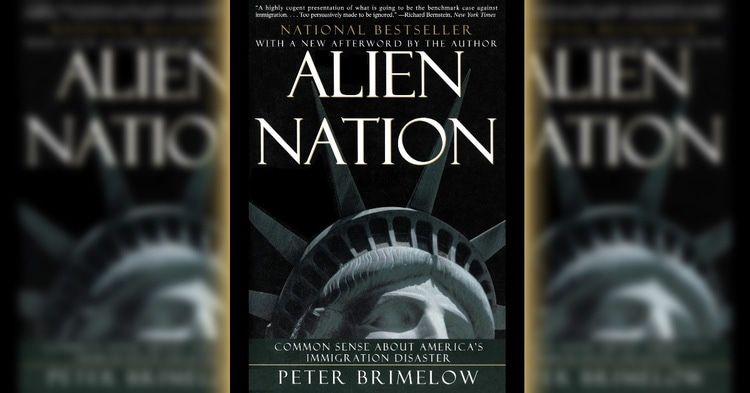


04/02/1995
By Stephan Thernstrom
The Washington Post
April 02, 1995
IF YOU liked California’s Proposition 187, you'll love Peter Brimelow’s Alien Nation. It, too, is raw meat that will offend politically correct members of the cultural elite. It may also strike a responsive chord with a great many ordinary Americans.
In 1965 the United States lifted many of the restrictions it had placed on immigration in the 1920s. As a result of the 1965 reforms, the total number of immigrants entering the country each year has increased dramatically; it is now quadruple the average in the Eisenhower and Kennedy years. In addition, the proportion of arrivals from Europe has fallen sharply, while the share from Asia and Latin America has soared. Many more immigrants are coming, and most are coming from other parts of the world than their predecessors did.
Is this a bad thing? Brimelow thinks so. It is no accident, he suggests, that the liberalization of our immigration law took place at the same time as the Civil Rights Act of 1965, the liberalization of the social welfare and criminal justice systems, and a variety of other Great Society social uplift programs. Many of these experiments had unintended and highly unfortunate consequences, and so too, he argues, did immigration reform. The central thesis of this volume is that over the past three decades immigration has become "so huge and so systematically different from anything that had gone before as to transform — and ultimately, perhaps, even to destroy — the … American nation." We are living through a "demographic mutation" without precedent "in the entire history of the world." Has recent immigration to the United States really been "huge"? Not really. In absolute numbers, current immigration is on about the same level as in the peak years earlier in this century. But in proportion to the total population, the more relevant comparison, it continues to be fairly low by historic standards. American history offers a long and clear precedent for immigration at something like the current level. As of 1990, the census reported that just 7.9 percent of the residents of the United States had been born in another country. That is lower than the figure on every census between 1850 and 1940. Indeed, it is not much more than half the proportion in 1870, 1890 and 1910. Even after making allowance for the fact that some of the millions of illegal immigrants in the country today doubtless eluded the census-taker, it is absurd to claim that the sheer number of immigrants in the country today constitutes an unprec edented challenge.
The claim that recent immigration is "systematically different from anything that had gone before" is equally misguided. By this, Brimelow means that almost all of the earlier immigrants to reach these shores were Europeans and that most of those today are "visible minorities from the Third World." By "visible" he means people with dark skins. When you enter the waiting room at an office of the Immigration and Naturalization Service, he reports in dismay, "you find yourself in an underworld that is not just teeming but is also almost entirely colored."
The contrast with the past is not nearly as sharp as he thinks. Early in this century, the Poles, Italians and Jews pouring in through Ellis Island were not welcomed by native observers as fellow "Europeans." The "new immigrants," the U.S. Immigration Commission reported after a massive, pseudoscientific study, were very different from the "old immigrants" of the previous century. They belonged to lower "races" and were innately unassimilable. Henry James recoiled as strongly from the immigrants he saw crowded in the lower East Side as Brimelow did from those at the INS office. But the "racial" differences that so horrified Henry James have long since faded into insignificance. It is quite possible — though by no means certain — that the color differences that obsess Brimelow today will likewise become inconsequential with the passage of time.
If Brimelow is wrong in his superheated claim that the post-1965 immigration has resulted in a "demographic mutation" that threatens the very survival of the American nation, he is on stronger ground in arguing that our society may be much less capable of absorbing newcomers than in the past. The most recent immigrant wave has crested on our shores at a time when the melting-pot ideal has been under assault and the concept of "Americanization" is frowned upon in enlightened circles. That many immigrants now belong to "protected" racial groups and are accordingly given affirmative-action preferences in education and employment conveys the unfortunate message that American whites would treat them unfairly in the absence of legal coercion — not a sentiment calculated to spur patriotic zeal. Moreover, our public schools, vital instruments of assimilation in the past, are caught up in the promotion of bilingual education and multiculturalism.
As a telling sign of what has changed, consider the tactics employed in the recent struggle against Proposition 187. Earlier immigrant groups understood how stupid it would be for them to brandish the German or Italian flag when protesting some public policy they opposed. When opponents of Proposition 187 decided to wrap themselves in the flag at rallies, though, it was the Mexican flag that they brandished.
Our problem is not too many immigrants, or even too many of the wrong kind of immigrant. The problem is with the larger political and social context within which immigration takes place. We need to breathe new life into the melting-pot ideal and discard social policies that encourage the Balkanization of our society.
Stephan Thernstrom, the Winthrop Professor of History at Harvard University, is the editor of "The Harvard Encyclopedia of American Ethnic Groups."
GRAPHIC: Illustration, Joseph Keppler’s 1880 cartoon, "Welcome to All."